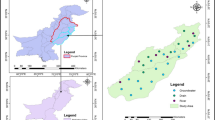Abstract
The concentrations of nutrients (total nitrogen, total phosphorus and organic matter) and metals (Cu, Pb, Zn, Ni, Cd, Cr, As and Hg) in sewage sludge samples were determined to evaluate the level of contamination. Sewage sludge samples were collected from ten wastewater treatment plants from 2016 to 2018 in Wuxi city, China. All the studied sewage sludge samples displayed high fertility properties due to their richness. Total concentrations of metals in the sewage sludge samples were within the regulation of the Chinese legislation. The levels of the eight metals temporally varied. Sewage sludge pollution assessment was undertaken using pollution index, geo-accumulation index, potential ecological risk index and aggregative toxicity index. Multivariate statistical analysis indicated that Pb, Cr, As and Hg may have similar transport behavior and derive from anthropogenic sources. Ecological risk assessment revealed that Hg contamination is the major concern for human health, since the treated sewage sludge is used for agricultural purposes.




Similar content being viewed by others
References
Chanpiwat P, Sthiannopkao S, Kim KW (2010) Metal content variation in wastewater and biosludge from Bangkok’s central wastewater treatment plants. Microchem J 95:326–332
Filipović J, Grčić I, Bermanec V, Kniewald g (2013) Monitoring of total metal concentration in sludge samples: case study for the mechanical-biological wastewater treatment plant in Velika Gorica, Croatia. Sci Total Environ 447:17–24
Hakanson L (1980) An ecological risk index for aquatic pollution control: a sedimentological approach. Water Res 14:975–1001
Jamshidi-Zanjani A, Saeedi M (2017) Multivariate analysis and geochemical approach for assessment of metal pollution state in sediment cores. Environ Sci Pollut Res 24:1–16
Li J, Luo GB, Gao JF, Yuan S, Du J, Wang ZH (2015) Quantitative evaluation of potential ecological risk of heavy metals in sewage sludge from three wastewater treatment plants in the main urban area of Wuxi, China. Chem Ecol 31:235–251
Long ER, MacDonald DD, Smith SL, Calder FD (1995) Incidence of adverse biological effects within ranges of chemical concentrations in marine and estuarine sediments. Environ Manag 19:81–97
McDonald DD, Ingersoll CG, Berger TA (2000) Development and evaluation of consensus-based sediment quality guidelines for freshwater ecosystems. Arch Environ Contam Toxicol 39:20–31
Müller G (1969) Index of geoaccumulation in sediments of the Rhine river. Geol J 2(3):108–118
Saeedi M, Jamshidi-Zanjani A (2015) Development of a new aggregative index to assess potential effect ofmetals pollution in aquatic sediments. Ecol Indic 58:235–243
Varol M, Şen B (2012) Assessment of nutrient and heavy metal contamination in surface water and sediments of the upper Tigris River, Turkey. Catena 92:1–10
Wei CY, Wen HL (2012) Geochemical baselines of heavy metals in the sediments of two large freshwater lakes in China: implications for contamination character and history. Environ Geochem Health 34:737–748
Yang G, Zhang G, Wang H (2015) Current state of sludge production, management, treatment and disposal in China. Water Res 78:60–73
Yang T, Huang HJ, Lai FY (2017) Pollution hazards of heavy metals in sewage sludge from four wastewater treatment plants in Nanchang, China. Trans Nonferrous Met Soc China 27:2249–2259
Zhang ZB, Lv YF, Zhang W, Zhang YH, Sun CZ, Marhaba T (2015) Phosphorus, organic matter and nitrogen distribution characteristics of the surface sediments in Nansi Lake, China. Environ Earth Sci 73:5669–5675
Zhang QH, Yang WN, Ngo HH, Guo WS, Jin PK, Dzakpasu M, Yang SJ, Wang Q, Wang XC, Ao D (2016) Current status of urban wastewater treatment plants in China. Environ Int 92–93:11–22
Zhao YF, Shi XZ, Huang B, Yu DS, Wang HJ, Sun WX, Oboern J, Blomback K (2007) Spatial distribution of heavy metals in agricultural soils of an industry-based peri-urban area in Wuxi. China Pedosphere 17:44–51
Zhu DW, Wei Y, Zhao YH, Wang QL, Han JC (2018a) Heavy Metal pollution and ecological risk assessment of the agriculture soil in Xunyang Mining Area, Shaanxi Province, Northwestern China. Bull Environ Contam Toxicol 101:178–184.
Zhu DW, Wu SZ, Han JC, Wang LJ, Qi MY (2018b) Evaluation of nutrients and heavy metals in the sediments of the Heer River, Shenzhen, China. Environ Monit Assess 190:380
Acknowledgements
This work was supported by the National Water Pollutant Control and Treatment Project Foundation of China (2015ZX07306001).
Author information
Authors and Affiliations
Corresponding author
Rights and permissions
About this article
Cite this article
Li, J., Luo, G. & Xu, J. Fate and Ecological Risk Assessment of Nutrients and Metals in Sewage Sludge from Ten Wastewater Treatment Plants in Wuxi City, China. Bull Environ Contam Toxicol 102, 259–267 (2019). https://doi.org/10.1007/s00128-018-2525-z
Received:
Accepted:
Published:
Issue Date:
DOI: https://doi.org/10.1007/s00128-018-2525-z




